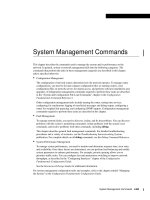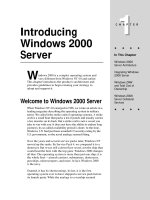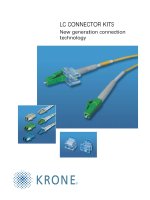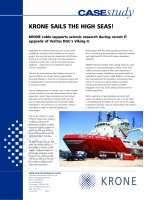Tài liệu OPTICAL WIRELESS COMMUNICATION SYSTEM doc
Bạn đang xem bản rút gọn của tài liệu. Xem và tải ngay bản đầy đủ của tài liệu tại đây (1.53 MB, 65 trang )
MODELING INTERSATELLITE OPTICAL WIRELESS
COMMUNICATION SYSTEM
AIDA HASFIZA BINTI HASHIM
UNIVERSITI TEKNOLOGI MALAYSIA
MODELING INTERSATELLITE OPTICAL WIRELESS
COMMUNICATION SYSTEM
AIDA HASFIZA BINTI HASHIM
A thesis submitted in fulfillment of the requirements
for the award of the degree
Bachelor of Electrical Engineering (Telecommunication)
Faculty of Electrical Engineering
Universiti Teknologi Malaysia
MAY 2009
ii
iii
To those who matters most to me.
iv
ACKNOWLEDGEMENT
My undivided gratitude to Allah S.W.T that has given me blessings and
strength to complete this project entitled “Modeling Intersatellite Optical Wireless
Communication System” successfully.
I wish to express my sincere appreciation to my Supervisor, Dr. Sevia M.
Idrus, for her constant guidance, counsels, and putting much effort upon the
completion of this project. I also would like to thank my lecturers in the Faculty of
Electrical Engineering who have taught me throughout the semesters. I am also
grateful to the Ministry of Higher Education for supporting this project under vote
number 78289.
Credits also given towards the researchers and staffs in Photonics
Technology Centre who are always willing to lend their hands and show me
guidance. Many thanks also to my mother, my sisters and the rest of my family
members for their encouragement, love and support.
Last but not least, for all my friends – Nadia, Norli, Farah, Huda, Julia and
the rest of my Electrical-Telecommunication Engineering classmates that had shared
their knowledge and experience with me throughout these four years of study. The
kindness, cooperation and support from all of them will always be remembered.
Thank you.
v
ABSTRACT
Optical communications systems have evolved from lengthy fibers to
powerful wireless system. This has hence resulted in the use of optical wireless
communication system in space communications. As the number of satellites
orbiting Earth increase year by year, a network between the satellites provides a
method for them to communicate with each other. This is important for satellites to
send information to one another and also to relay the information from one satellite
to another satellite and then to the ground stations. In this research, the intersatellite
communication link is studied and optical wireless communication was proposed for
the link. The intersatellite optical wireless communication (IsOWC) system was
designed and simulated for performance characterization. The intersatellite link was
modeled and simulated using a commercial optical system simulator named
OptiSystem by Optiwave. The findings of this project shows that by using laser
satellite communication system, the satellites can be connected with data rates up to
10Gbps. This thesis fully discusses the free space optic system technology for
intersatellite communication link for future development of large data transfer
between satellites with high Quality of Service (QoS). The system performance
including bit rates, receiver sensitivity and distance of LEO and GEO intersatellite
links were analyzed.
vi
ABSTRAK
Sistem komunikasi optik telah berkembang dari kabel-kabel fiber ke sistem
wayarles yang canggih. Ini telah mengembangkan penggunaan teknologi optik ke
sistem komunikasi angkasa lepas. Dengan pertambahan bilangan satelit di orbit dari
tahun ke tahun, jaringan perhubungan antara satelit-satelit ini dapat memberi satu
kaedah untuk ia berhubung. Ini adalah penting untuk satu satelit menerima dan
menghantar data dari satu satelit ke satelit yang lain dan juga ke bumi. Dalam kajian
ini, komunikasi antara satelit telah dipelajari dan komukasi optik wayarles telah
dicadangkan. Sistem komunikasi optik wayarles antara satelit (IsOWC) telah
direkabentuk dan disimulasi untuk kajian prestasi sistem. Talian antara satelit itu
telah dimodel dan disimulasi menggunakan perisian OptiSystem dari Optiwave.
Hasil daripada kajian ini telah menunjukkan bahawa dengan menggunakan sistem
komunikasi laser, satelit-satelit dapat dihubungkandengan kadar data mencecah
10Gbps. Tesis ini membincangkan secara keseluruhan sistem teknologi optik ruang
bebas untuk talian komunikasi antara satelit dengan perpindahan data yang besar dan
juga kualiti servis (QoS) yg tinggi untuk masa hadapan. Prestasi sistem seperti kadar
data, sensitiviti penerima, dan jarak antara satelit-satelit LEO dan GEO telah dikaji.
vii
TABLE OF CONTENTS
CHAPTER
TITLE
PAGE
DECLARATION
DEDICATION
ACKNOWLEDGEMENT
ABSTRACT
ABSTRAK
TABLE OF CONTENTS
LIST OF TABLES
LIST OF FIGURES
LIST OF ABBREVIATIONS
ii
iii
iv
v
vi
vii
x
xi
xiii
1
INTRODUCTION
1.1 Introduction
1.2 Overview of Satellites
1.3 Project Objectives
1.4 Scope of Work
1.5 Problem Statement
1.6 Thesis Outline
1
3
4
5
5
6
2
BASIC CONCEPT AND THEORIES
2.1 Introduction
2.2 Intersatellite Link Developments
2.3 Optical Wireless Communication Concepts
2.3.1 Optical Wireless System
8
8
9
10
viii
2.3.2 System Performance
2.3.3 Attenuation and Link Power Budget
2.4 Related Researches
2.5 Intersatellite Optical Link Applications
2.5.1 Data Relay for Inter Orbit Satellites
2.5.2 Connecting Constellations of Satellites
2.6 Conclusions
14
14
15
19
19
21
22
3
PROJECT METHODOLOGY
3.1 Introduction
3.2 Study the OWC System
3.3 Study the Intersatellite Link System
3.4 Design the IsOWC Basic System Model
3.5 IsOWC System Simulation of Model for
Characteristics Performance
3.6 Result Analysis
3.7 Presentation and Thesis Writing
3.8 Conclusions
23
25
25
25
26
26
27
27
4
SYSTEM MODELING
4.1 Introduction
4.2 OptiSystem Software
4.3 System Model in OptiSystem
4.4 System Components
4.4.1 IsOWC Transmitter Design
4.4.2 OWC Channel
4.4.3 IsOWC Receiver Design
4.5 Conclusions
28
28
29
30
31
33
33
35
5
RESULT ANALYSIS
5.1 Introduction
5.2 Relationship between Q-factor and Bit rates with
Distance of Intersatellite Link
36
37
ix
5.3 Relationship between Q-factor and Signal
Wavelength
5.4 Relationship between Diameter of Optical
Antennae with Received Power and Distance
5.5 Conclusions
40
42
44
6
CONCLUSIONS
6.1 Conclusions
6.2 Future Work Recommendations
45
46
REFERENCES
48
x
LIST OF TABLES
TABLE NO.
TITLE
PAGE
5.1
Maximum Q-factor recorded for respective signal
wavelengths
42
xi
LIST OF FIGURES
FIGURE NO.
TITLE
PAGE
1.1
Overview of IsOWC
2
1.2
Earth Satellite Communication Orbits
4
2.1
Optical intersatellite link between Artemis and
SPOT-4 first achieved in March 2003
9
2.2
IsOWC basic system block diagram for simplex
communication
10
2.3
Optical modulation process where input light is
varied according to electrical signal to produce
light pulses
12
2.4
Optical antennae increase the signal divergence
12
2.5
APD photodetector structure
13
2.6
Link attenuation for (a) LEO-LEO link and (b)
GEO-GEO link
17
2.7
Optical satellite network creating a global
connection
18
2.8
High-level optical intersatellite communication
system
19
2.9
Concept of data relay for inter orbit IsOWC
20
2.10
Data relay methods (a) conventional (b) using
intersatellite data relay
21
2.11
Constellations of satellite orbiting Earth
22
xii
3.1
The project methodology
24
4.1
IsOWC first design with basic subsystems
29
4.2
IsOWC simplex design model
29
4.3
IsOWC full-duplex system between two satellites
30
4.4
NRZ encoding technique
31
4.5
Mach-Zehnder Modulator varies the light intensity
according to voltage
32
4.6
BER analyzer is connected to the transmitter when
without 3R regenerator
34
4.7
Connection of the BER analyzer to the 3R
regenerator
35
5.1
Maximum achievable Q-factor for variable distance
at 1550nm IsOWC link for bitrate up to 10Gbps
37
5.2
Eye-diagram for IsOWC system at distance
1000km and 10Mbps
38
5.3
Eye-diagram obtained at distance 3000km and
10Mbps bit rate
39
5.4
Eye diagram for IsOWC system with bit rate 1Gbps
at 1000km distance
39
5.5
Eye diagram for system at 850nm wavelength
40
5.6
System eye diagram obtained at wavelength 950nm
41
5.7
Eye diagram for 1550nm signal
41
5.8
Received power for respective optical antennae
diameter at distance up to 5000km and input power
of 10dBm
44
xiii
LIST OF ABBREVIATIONS
OWC - Optical Wireless Communication
IsOWC - Intersatellite Optical Wireless Communication
RF - Radio Frequency
SCORE - Signal Communication by Orbital Relay
LEO - Low Earth Orbit
MEO - Medium Earth Orbit
GEO - Geosynchronous Orbit
BER - Bit Error Rate
NASA - National American Space Agency
TDRSS - Tracking and Data Relay Satellite System
ESA - European Space Agency
SPOT-4 - Satellite Pour L`Observation De La Terre 4
TT&C - Telemetry, Tracking and Communication
LED - Light Emitting Diode
ILD - Injecting Laser Diode
APD - Avalanche Photodiode
NRZ - Non-return Zero
CW - Continuous wave
CHAPTER 1
INTRODUCTION
1.1 Introduction
As of April 2009, there are 6124 satellites orbiting Earth and this number
increases year by year [1]. At the same time, the optical wireless communication
(OWC) technology has grown and advanced throughout the year. Laser
communication is now able to send information at data rates up to several Gbps and
at distance of thousands of kilometers apart. This has open up the idea to adapt
optical wireless communication technology into space technology; hence
intersatellite optical wireless communication (IsOWC) is developed.
IsOWC can be used to connect one satellite to another, whether the satellite is
in the same orbit or in different orbits. With light travelling at 3 x 10
8
m/s, data can
be sent without much delay and with minimum attenuation since the space is
considered to be vacuum. The advantages of using optical link over radio frequency
(RF) links is the ability to send high speed data to a distance of thousands of
kilometers using small size payload [2]. By reducing the size of the payload, the
mass and the cost of the satellite will also be decreased. Another reason of using
OWC is due to wavelength. RF wavelength is much longer compared to lasers hence
2
the beamwidth that can be achieved using lasers is narrower than that of the RF
system [3]. Due to this reason, OWC link results in lower loss compared to RF but
it requires a highly accurate tracking system to make sure that the connecting
satellites are aligned and have line of sight.
Figure 1.1 Overview of IsOWC
This project is done to study the intersatellite communication employing
optical communication link. The effects of distance between satellites, bit rates,
input power, optical antennae, and receiver sensitivity is studied and discussed in this
thesis while assuming that the satellites have line of sight.
3
1.2 Overview of Satellites
A satellite is an object that orbits or revolves around another object in space.
The Moon is a satellite to Earth and the Earth is a satellite to the Sun. Those are
natural satellite. In 1945, Arthur Clarke wrote on the possibilities of having man-
made satellites that could be able to relay telephone channels and broadcast
programs. Thirteen years later, the first communication satellite named SCORE
(Signal Communication by Orbital Relay) was launched and proved that Clarke’s
theory was indeed possible. Following the success of SCORE, many more satellites
were launched by the United States, Russia, United Kingdom and Canada. Since
then, satellites are launched up to space for many applications such as for
communication, remote sensing, scientific research and global positioning.
Satellites revolve around Earth at their own orbit and there are three
commonly used orbits for satellites. Low Earth Orbit (LEO) is the orbit closest to
Earth with altitude of 100km to 5,000km. LEO satellites take from 2 to 4 hours to
rotate around Earth. This orbit is commonly used for multi-satellite constellations
where several satellites are launched up to space to perform a single mission. The
Medium Earth Orbit (MEO) is from 10,000km to 20,000km altitude and the orbital
period is from 4 to 12 hours. MEO orbit is usually occupied by remote sensing
satellites. Communication satellites for broadcasting and telephone relay is placed in
the Geosynchronous Orbit (GEO) which has 36,000km altitude from Earth. A GEO
satellite takes 24 hours to rotate around Earth which makes it seem like stationary
from Earth’s point of view [4]. Figure 1.2 shows the satellite orbits around Earth.
4
Figure 1.2 Earth Satellite Communication Orbits
1.3 Project Objectives
This project was done to fulfill these objectives:
i) To study the optical wireless communication system for intersatellite links.
ii) To design the intersatellite optical wireless communication system for GEO
and LEO satellites.
iii) To model and simulate the intersatellite link for performance
characterization.
5
1.4 Scope of Work
A few guidelines are proposed so that this project is narrowed to a certain
boundaries. This is to ensure that this project achieves its objectives.
Firstly, the environment surrounding the satellites is assumed to be vacuum.
It is also assume that the satellites for intersatellite link are aligned and have line of
sight. Hence, the presence of any large particle that may obstruct the line of sight is
not studied in this project.
This project models basic optical communication system where no advanced
modulation, multiplexing or coding technique is used. The software that is used to
model the IsOWC system is Optiwave’s OptiSystem. Therefore, the result of system
performance relies on the software and the channel characteristic follows the
software’s OWC channel characteristic.
To analyze the system, parameters that can affect the system performance
such as distance between the transmitter and receiver, data bit rate, input power and
wavelength are varied. The performance of the system is measured in terms of the
bit error rate (BER), Q-factor and received power retrieved from the software.
1.5 Problem Statement
Conventional communication between satellites and also to Earth is by using
RF system. The problem with RF system is that there are many limitations in the
6
systems, limitation that optical links can recover. Frequency is one of the many
limitations of RF links as there are regulations and license to the frequency that can
be used for satellite communications. The regulations are not applicable in optical
link. Since optical link are able to transmit very high frequency which is up to
194THz for wavelength 1550nm, therefore it can support high data rate transmission
[5]. For intersatellite communications, signal need to travel thousands of kilometers
from one satellite to another. If RF system is to be employed, the size of the
transmitting and receiving antenna that is needed would be very big (about meters
wide) and also heavy, compared to using optical link that would only need an optical
antenna of several centimeters big. Reducing size and weight of the satellite’s
payload can reduce the cost of the satellite, which is what every satellite designer
aims for.
1.6 Thesis Outline
This thesis consists of six chapters. Chapter 1 introduces the project and
discusses the basics of satellites. Chapter 1 also presents the objective of the project
and the scope of work to achieve the objectives. That is followed by the problem
statement which explains why this project is done.
Chapter 2 discusses the theory and literature review of the project. The
chapter begins with brief explanations on intersatellite developments. Then, the
chapter discusses on OWC concepts where the fundamentals of OWC system,
attenuation and power budget calculation is explained. The chapter then presents the
OWC system performance analysis method and compares fiber optic system to OWC
system. The chapter also presents some researches that are relevant to the project.
Finally, some applications of optical intersatellite links are presented at the end of the
chapter.
7
In Chapter 3, the methodology of the project is presented and explained in
details of each steps in the methodology. The chapter explains the process of this
project from research study of OWC and satellites to modeling, simulating, gathering
results, analyzing and writing this thesis report.
Chapter 4 presents the system model that had been designed. The
OptiSystem software that is used to model the IsOWC system is briefly discussed.
Each subsystem in the system is also explained in the chapter.
The findings of this project are presented in Chapter 5. The system
performance is presented in graphs and figures and is then discussed. System
performance is measured in Q-factor and the signal received power. The relationship
of these parameters with varying input parameter such as bit rates and distance is
conferred in this chapter.
The final chapter is Chapter 6 where the overall project is concluded. The
chapter answers on whether the project objectives are successfully accomplished and
then concludes the findings of this project. Lastly, some recommendations were
stated on future work that can be continued and improved from this project.
CHAPTER 2
BASIC CONCEPT AND THEORIES
2.1 Introduction
In this chapter, the concept and theories of intersatellite links and OWC
system will be discussed. The development of intersatellite communication and the
important theories related to OWC is covered in this chapter.
2.2 Intersatellite Link Developments
Intersatellite links have been employed on several satellite systems such as
Iridium and National American Space Agency (NASA)’s Tracking and Data Relay
Satellite System (TDRSS) where RF is used to link the satellites. However, optical
links has been proven to provide higher bit rates and better efficiency than RF link.
Hence, several satellites have been implanted with OWC intersatellite links such as
European Space Agency (ESA)’s Artemis and Japan’s Kirari satellites. The first
9
intersatellite communication employing optical link was successfully achieved on
March 2003 between Artemis and French satellite named Satellite Pour
L`Observation De La Terre 4 or SPOT-4 [6]. The simplex communication from
Artemis to SPOT-4 was done by using data transmitted at 50Mbps with signal
wavelength of 850nm and optical signal with the power of 120mW. Artemis was
placed in the GEO satellite while SPOT-4 was in LEO at altitude of 832km. In
December 2005, a full-duplex communication between Artemis and Kirari was
achieved. These two experiments have shown that IsOWC is possible. Figure 2.1
shows the overview of optical communication link between Artemis and SPOT-4 [7].
Figure 2.1 Optical intersatellite link between Artemis and SPOT-4 first achieved
in March 2003
2.3 Optical Wireless Communication Concepts
Different from RF links, OWC uses light at near-infrared frequency to
communicate. OWC system still consists of three main communication parts which
Optical link









